Business Development Case Study: Sydney Symphony Orchestra (SSO)
VerifiedAdded on 2023/06/07
|9
|1820
|80
Case Study
AI Summary
This case study analyzes the business strategy of the Sydney Symphony Orchestra (SSO), Australia's flagship orchestra, established in 1932. It examines the internal and external factors influencing the SSO's operations, utilizing Porter's Five Forces and PESTLE analysis. The study identifies threats from substitutes and bargaining power of customers, while also highlighting opportunities in the political, economic, social, technological, legal, and environmental landscape of Australia. The case study proposes a systematic business plan focusing on risk management, advertising, talent acquisition, corporate funding, and cooperative strategies to revitalize the SSO. Recommendations include government support through tax reforms or funding, encouraging younger audiences, and emphasizing collaborative ventures to reduce costs and enhance audience engagement, ultimately aiming to restore the SSO to its former glory and cultural significance.

TITLE: SYDNEY
SYMPHONY
ORCHESTRA
(SSO)
SYMPHONY
ORCHESTRA
(SSO)
Paraphrase This Document
Need a fresh take? Get an instant paraphrase of this document with our AI Paraphraser
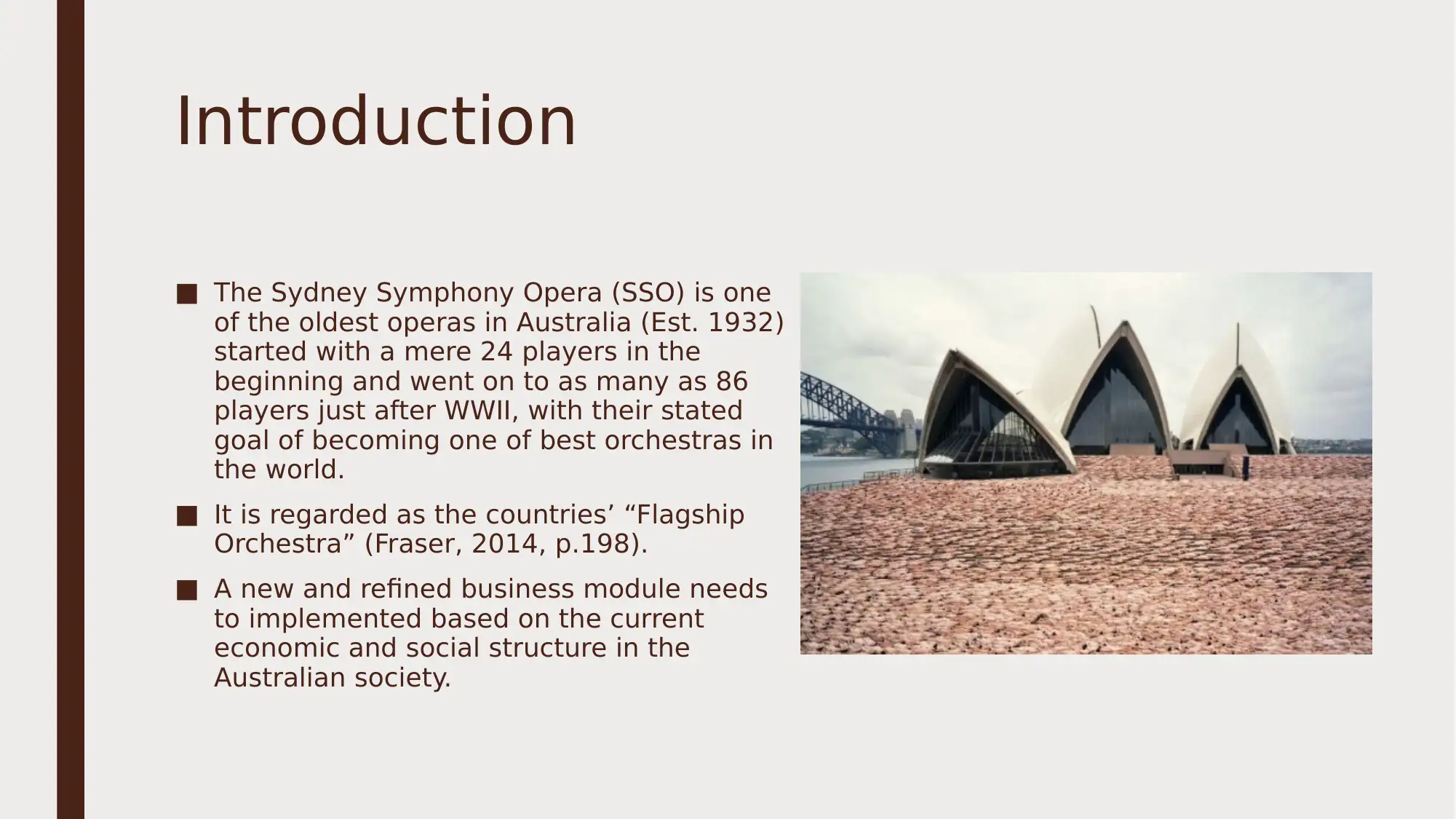
Introduction
■ The Sydney Symphony Opera (SSO) is one
of the oldest operas in Australia (Est. 1932)
started with a mere 24 players in the
beginning and went on to as many as 86
players just after WWII, with their stated
goal of becoming one of best orchestras in
the world.
■ It is regarded as the countries’ “Flagship
Orchestra” (Fraser, 2014, p.198).
■ A new and refined business module needs
to implemented based on the current
economic and social structure in the
Australian society.
■ The Sydney Symphony Opera (SSO) is one
of the oldest operas in Australia (Est. 1932)
started with a mere 24 players in the
beginning and went on to as many as 86
players just after WWII, with their stated
goal of becoming one of best orchestras in
the world.
■ It is regarded as the countries’ “Flagship
Orchestra” (Fraser, 2014, p.198).
■ A new and refined business module needs
to implemented based on the current
economic and social structure in the
Australian society.
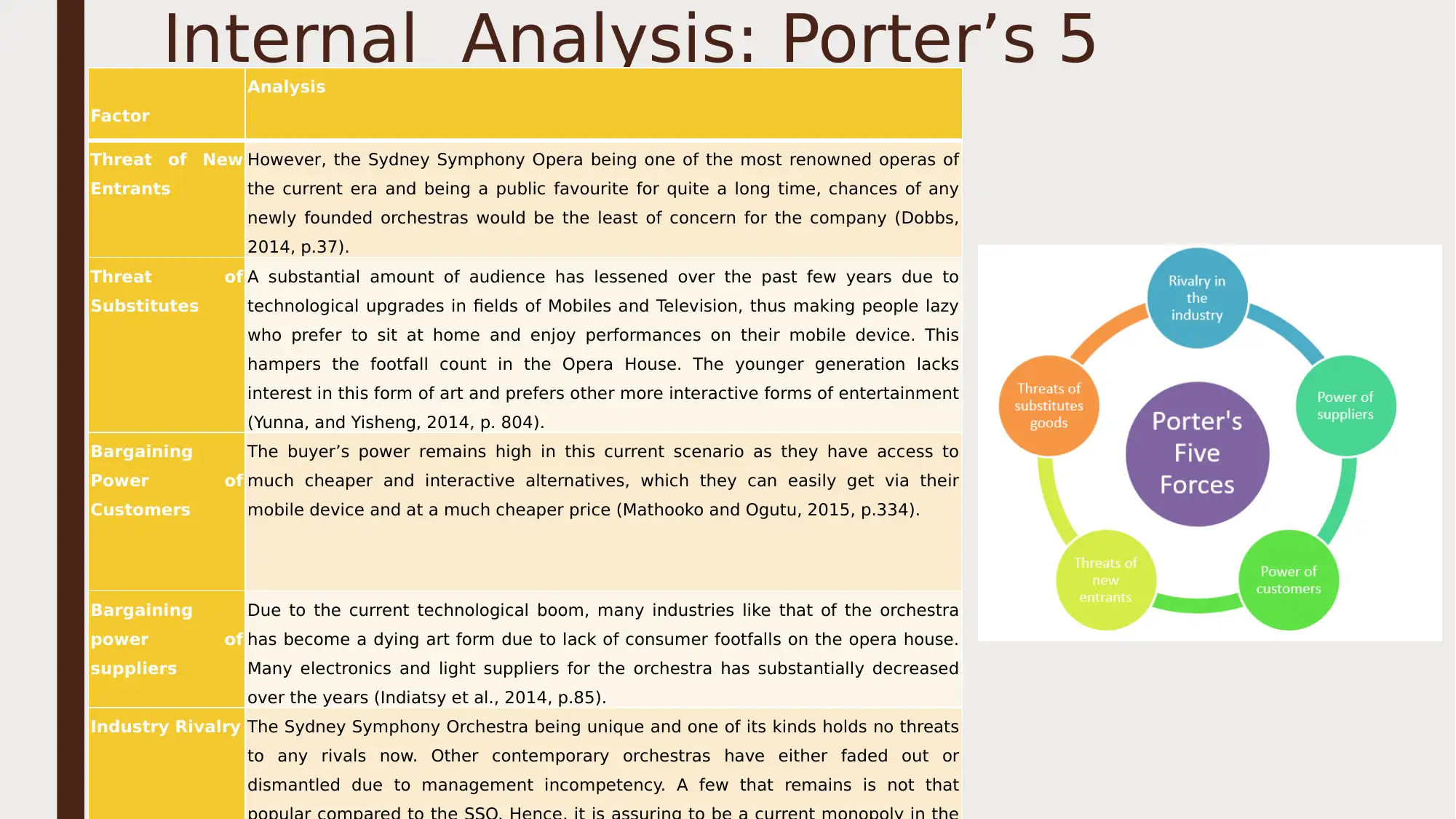
Internal Analysis: Porter’s 5
ForcesFactor
Analysis
Threat of New
Entrants
However, the Sydney Symphony Opera being one of the most renowned operas of
the current era and being a public favourite for quite a long time, chances of any
newly founded orchestras would be the least of concern for the company (Dobbs,
2014, p.37).
Threat of
Substitutes
A substantial amount of audience has lessened over the past few years due to
technological upgrades in fields of Mobiles and Television, thus making people lazy
who prefer to sit at home and enjoy performances on their mobile device. This
hampers the footfall count in the Opera House. The younger generation lacks
interest in this form of art and prefers other more interactive forms of entertainment
(Yunna, and Yisheng, 2014, p. 804).
Bargaining
Power of
Customers
The buyer’s power remains high in this current scenario as they have access to
much cheaper and interactive alternatives, which they can easily get via their
mobile device and at a much cheaper price (Mathooko and Ogutu, 2015, p.334).
Bargaining
power of
suppliers
Due to the current technological boom, many industries like that of the orchestra
has become a dying art form due to lack of consumer footfalls on the opera house.
Many electronics and light suppliers for the orchestra has substantially decreased
over the years (Indiatsy et al., 2014, p.85).
Industry Rivalry The Sydney Symphony Orchestra being unique and one of its kinds holds no threats
to any rivals now. Other contemporary orchestras have either faded out or
dismantled due to management incompetency. A few that remains is not that
ForcesFactor
Analysis
Threat of New
Entrants
However, the Sydney Symphony Opera being one of the most renowned operas of
the current era and being a public favourite for quite a long time, chances of any
newly founded orchestras would be the least of concern for the company (Dobbs,
2014, p.37).
Threat of
Substitutes
A substantial amount of audience has lessened over the past few years due to
technological upgrades in fields of Mobiles and Television, thus making people lazy
who prefer to sit at home and enjoy performances on their mobile device. This
hampers the footfall count in the Opera House. The younger generation lacks
interest in this form of art and prefers other more interactive forms of entertainment
(Yunna, and Yisheng, 2014, p. 804).
Bargaining
Power of
Customers
The buyer’s power remains high in this current scenario as they have access to
much cheaper and interactive alternatives, which they can easily get via their
mobile device and at a much cheaper price (Mathooko and Ogutu, 2015, p.334).
Bargaining
power of
suppliers
Due to the current technological boom, many industries like that of the orchestra
has become a dying art form due to lack of consumer footfalls on the opera house.
Many electronics and light suppliers for the orchestra has substantially decreased
over the years (Indiatsy et al., 2014, p.85).
Industry Rivalry The Sydney Symphony Orchestra being unique and one of its kinds holds no threats
to any rivals now. Other contemporary orchestras have either faded out or
dismantled due to management incompetency. A few that remains is not that
⊘ This is a preview!⊘
Do you want full access?
Subscribe today to unlock all pages.

Trusted by 1+ million students worldwide
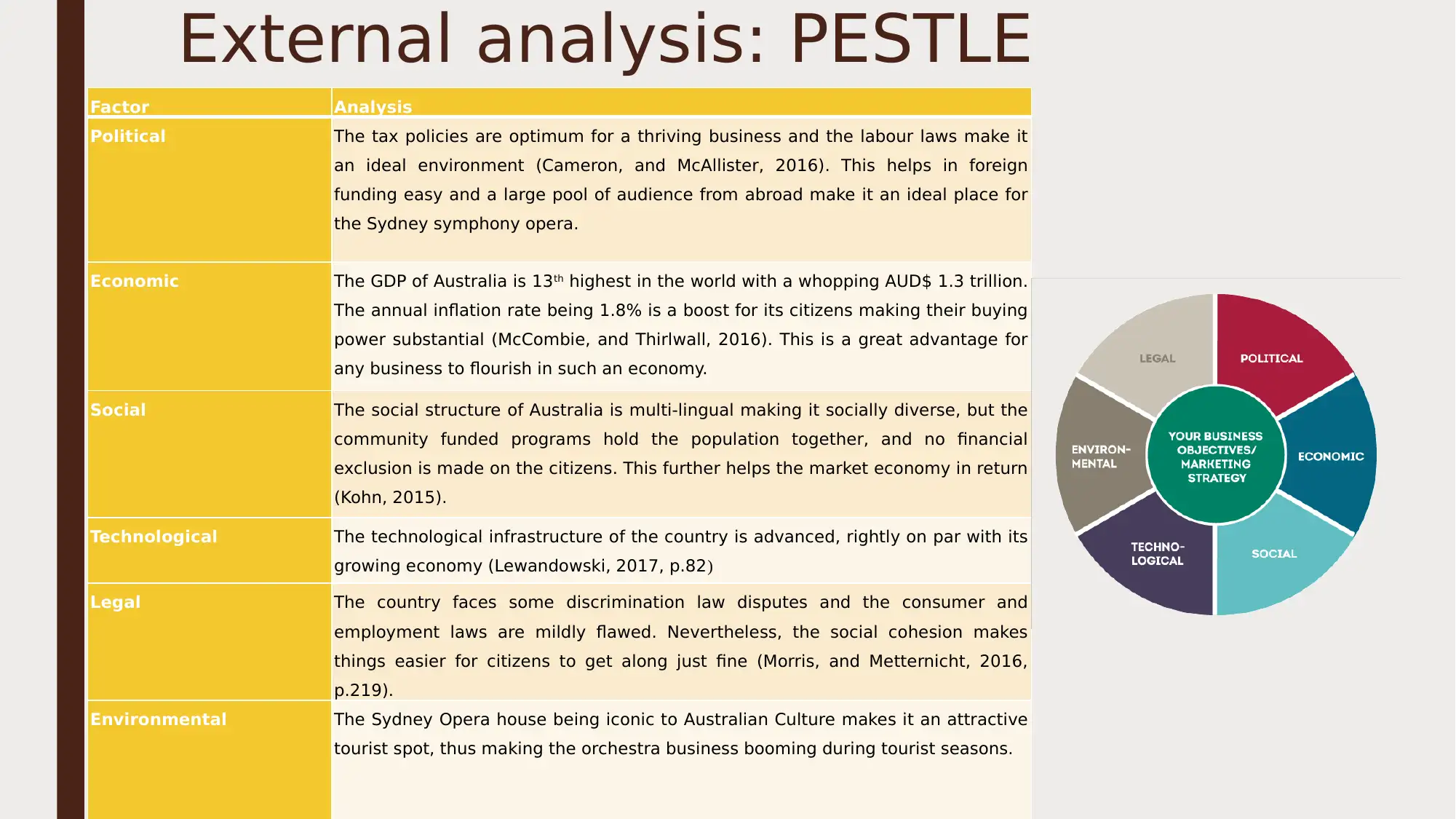
External analysis: PESTLE
Factor Analysis
Political The tax policies are optimum for a thriving business and the labour laws make it
an ideal environment (Cameron, and McAllister, 2016). This helps in foreign
funding easy and a large pool of audience from abroad make it an ideal place for
the Sydney symphony opera.
Economic The GDP of Australia is 13th highest in the world with a whopping AUD$ 1.3 trillion.
The annual inflation rate being 1.8% is a boost for its citizens making their buying
power substantial (McCombie, and Thirlwall, 2016). This is a great advantage for
any business to flourish in such an economy.
Social The social structure of Australia is multi-lingual making it socially diverse, but the
community funded programs hold the population together, and no financial
exclusion is made on the citizens. This further helps the market economy in return
(Kohn, 2015).
Technological The technological infrastructure of the country is advanced, rightly on par with its
growing economy (Lewandowski, 2017, p.82)
Legal The country faces some discrimination law disputes and the consumer and
employment laws are mildly flawed. Nevertheless, the social cohesion makes
things easier for citizens to get along just fine (Morris, and Metternicht, 2016,
p.219).
Environmental The Sydney Opera house being iconic to Australian Culture makes it an attractive
tourist spot, thus making the orchestra business booming during tourist seasons.
Factor Analysis
Political The tax policies are optimum for a thriving business and the labour laws make it
an ideal environment (Cameron, and McAllister, 2016). This helps in foreign
funding easy and a large pool of audience from abroad make it an ideal place for
the Sydney symphony opera.
Economic The GDP of Australia is 13th highest in the world with a whopping AUD$ 1.3 trillion.
The annual inflation rate being 1.8% is a boost for its citizens making their buying
power substantial (McCombie, and Thirlwall, 2016). This is a great advantage for
any business to flourish in such an economy.
Social The social structure of Australia is multi-lingual making it socially diverse, but the
community funded programs hold the population together, and no financial
exclusion is made on the citizens. This further helps the market economy in return
(Kohn, 2015).
Technological The technological infrastructure of the country is advanced, rightly on par with its
growing economy (Lewandowski, 2017, p.82)
Legal The country faces some discrimination law disputes and the consumer and
employment laws are mildly flawed. Nevertheless, the social cohesion makes
things easier for citizens to get along just fine (Morris, and Metternicht, 2016,
p.219).
Environmental The Sydney Opera house being iconic to Australian Culture makes it an attractive
tourist spot, thus making the orchestra business booming during tourist seasons.
Paraphrase This Document
Need a fresh take? Get an instant paraphrase of this document with our AI Paraphraser
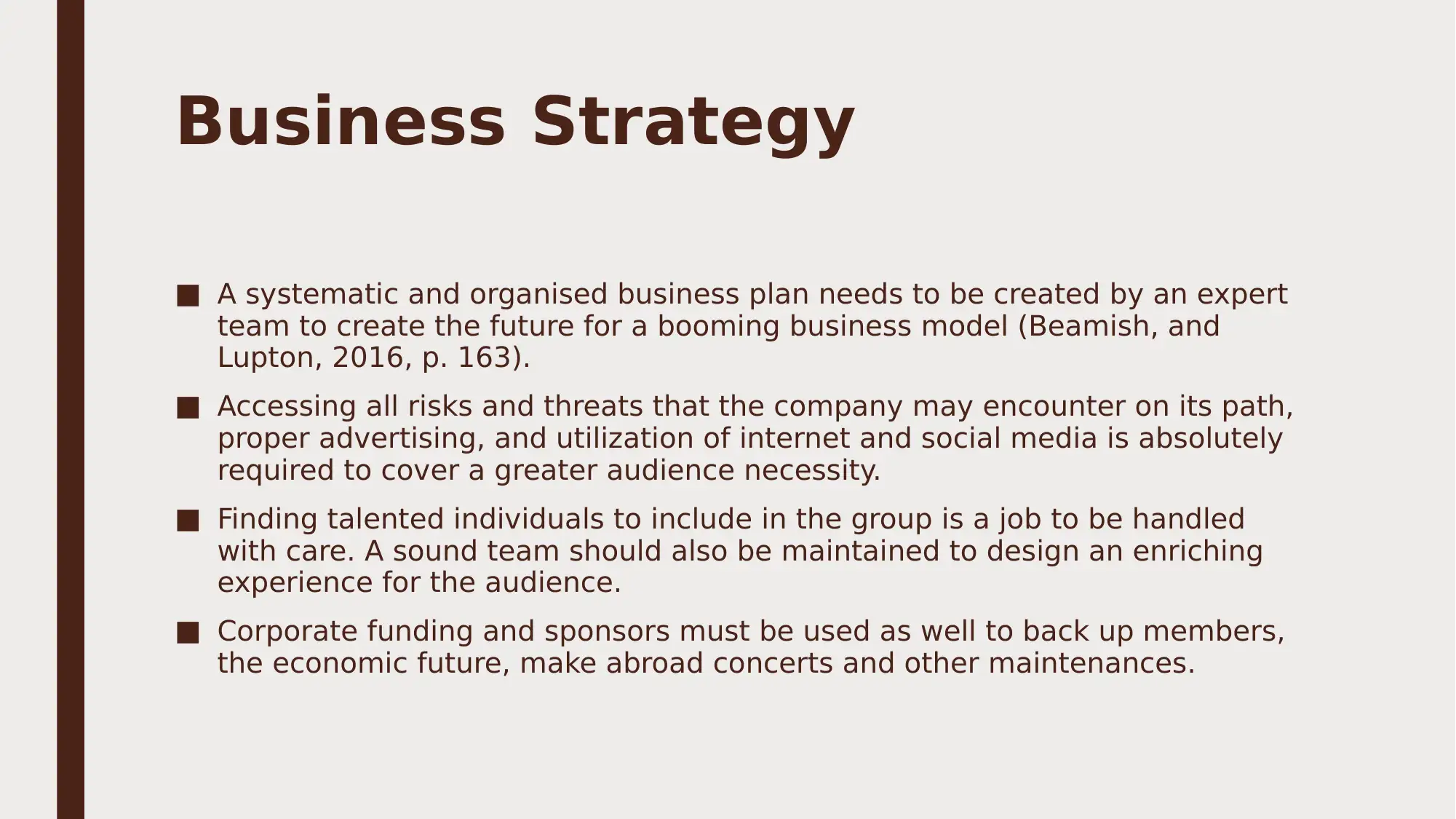
Business Strategy
■ A systematic and organised business plan needs to be created by an expert
team to create the future for a booming business model (Beamish, and
Lupton, 2016, p. 163).
■ Accessing all risks and threats that the company may encounter on its path,
proper advertising, and utilization of internet and social media is absolutely
required to cover a greater audience necessity.
■ Finding talented individuals to include in the group is a job to be handled
with care. A sound team should also be maintained to design an enriching
experience for the audience.
■ Corporate funding and sponsors must be used as well to back up members,
the economic future, make abroad concerts and other maintenances.
■ A systematic and organised business plan needs to be created by an expert
team to create the future for a booming business model (Beamish, and
Lupton, 2016, p. 163).
■ Accessing all risks and threats that the company may encounter on its path,
proper advertising, and utilization of internet and social media is absolutely
required to cover a greater audience necessity.
■ Finding talented individuals to include in the group is a job to be handled
with care. A sound team should also be maintained to design an enriching
experience for the audience.
■ Corporate funding and sponsors must be used as well to back up members,
the economic future, make abroad concerts and other maintenances.
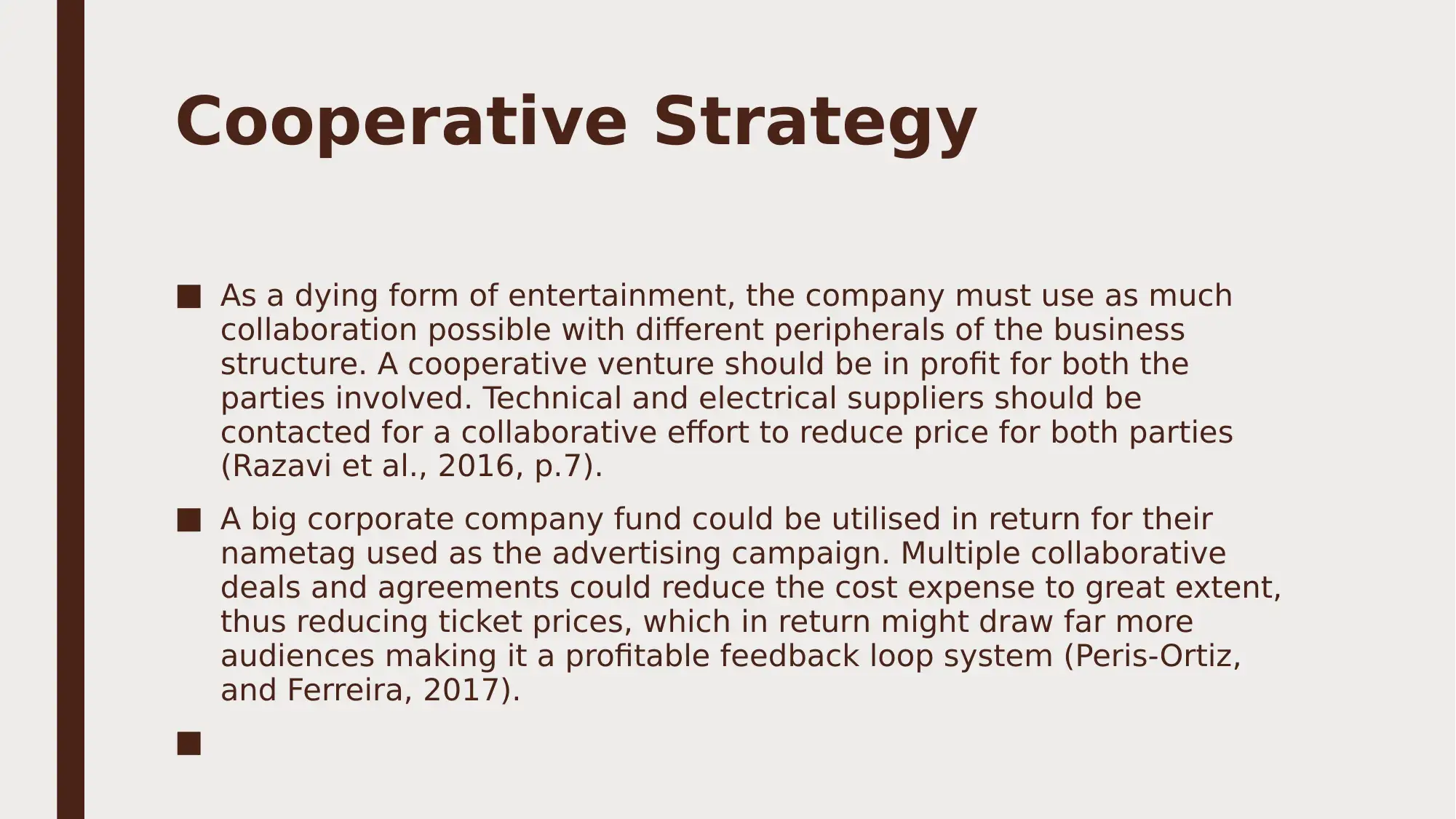
Cooperative Strategy
■ As a dying form of entertainment, the company must use as much
collaboration possible with different peripherals of the business
structure. A cooperative venture should be in profit for both the
parties involved. Technical and electrical suppliers should be
contacted for a collaborative effort to reduce price for both parties
(Razavi et al., 2016, p.7).
■ A big corporate company fund could be utilised in return for their
nametag used as the advertising campaign. Multiple collaborative
deals and agreements could reduce the cost expense to great extent,
thus reducing ticket prices, which in return might draw far more
audiences making it a profitable feedback loop system (Peris-Ortiz,
and Ferreira, 2017).
■
■ As a dying form of entertainment, the company must use as much
collaboration possible with different peripherals of the business
structure. A cooperative venture should be in profit for both the
parties involved. Technical and electrical suppliers should be
contacted for a collaborative effort to reduce price for both parties
(Razavi et al., 2016, p.7).
■ A big corporate company fund could be utilised in return for their
nametag used as the advertising campaign. Multiple collaborative
deals and agreements could reduce the cost expense to great extent,
thus reducing ticket prices, which in return might draw far more
audiences making it a profitable feedback loop system (Peris-Ortiz,
and Ferreira, 2017).
■
⊘ This is a preview!⊘
Do you want full access?
Subscribe today to unlock all pages.

Trusted by 1+ million students worldwide
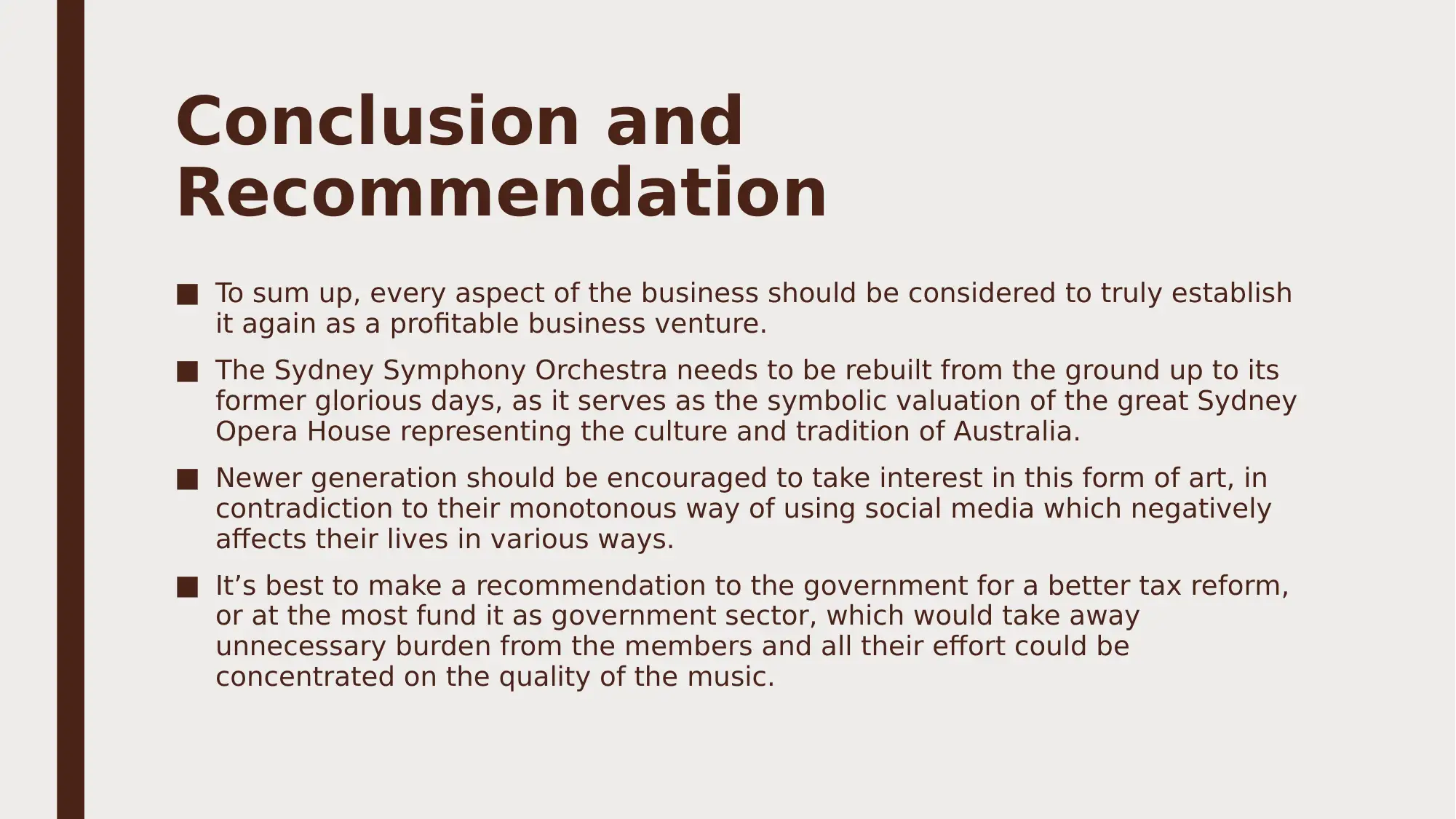
Conclusion and
Recommendation
■ To sum up, every aspect of the business should be considered to truly establish
it again as a profitable business venture.
■ The Sydney Symphony Orchestra needs to be rebuilt from the ground up to its
former glorious days, as it serves as the symbolic valuation of the great Sydney
Opera House representing the culture and tradition of Australia.
■ Newer generation should be encouraged to take interest in this form of art, in
contradiction to their monotonous way of using social media which negatively
affects their lives in various ways.
■ It’s best to make a recommendation to the government for a better tax reform,
or at the most fund it as government sector, which would take away
unnecessary burden from the members and all their effort could be
concentrated on the quality of the music.
Recommendation
■ To sum up, every aspect of the business should be considered to truly establish
it again as a profitable business venture.
■ The Sydney Symphony Orchestra needs to be rebuilt from the ground up to its
former glorious days, as it serves as the symbolic valuation of the great Sydney
Opera House representing the culture and tradition of Australia.
■ Newer generation should be encouraged to take interest in this form of art, in
contradiction to their monotonous way of using social media which negatively
affects their lives in various ways.
■ It’s best to make a recommendation to the government for a better tax reform,
or at the most fund it as government sector, which would take away
unnecessary burden from the members and all their effort could be
concentrated on the quality of the music.
Paraphrase This Document
Need a fresh take? Get an instant paraphrase of this document with our AI Paraphraser
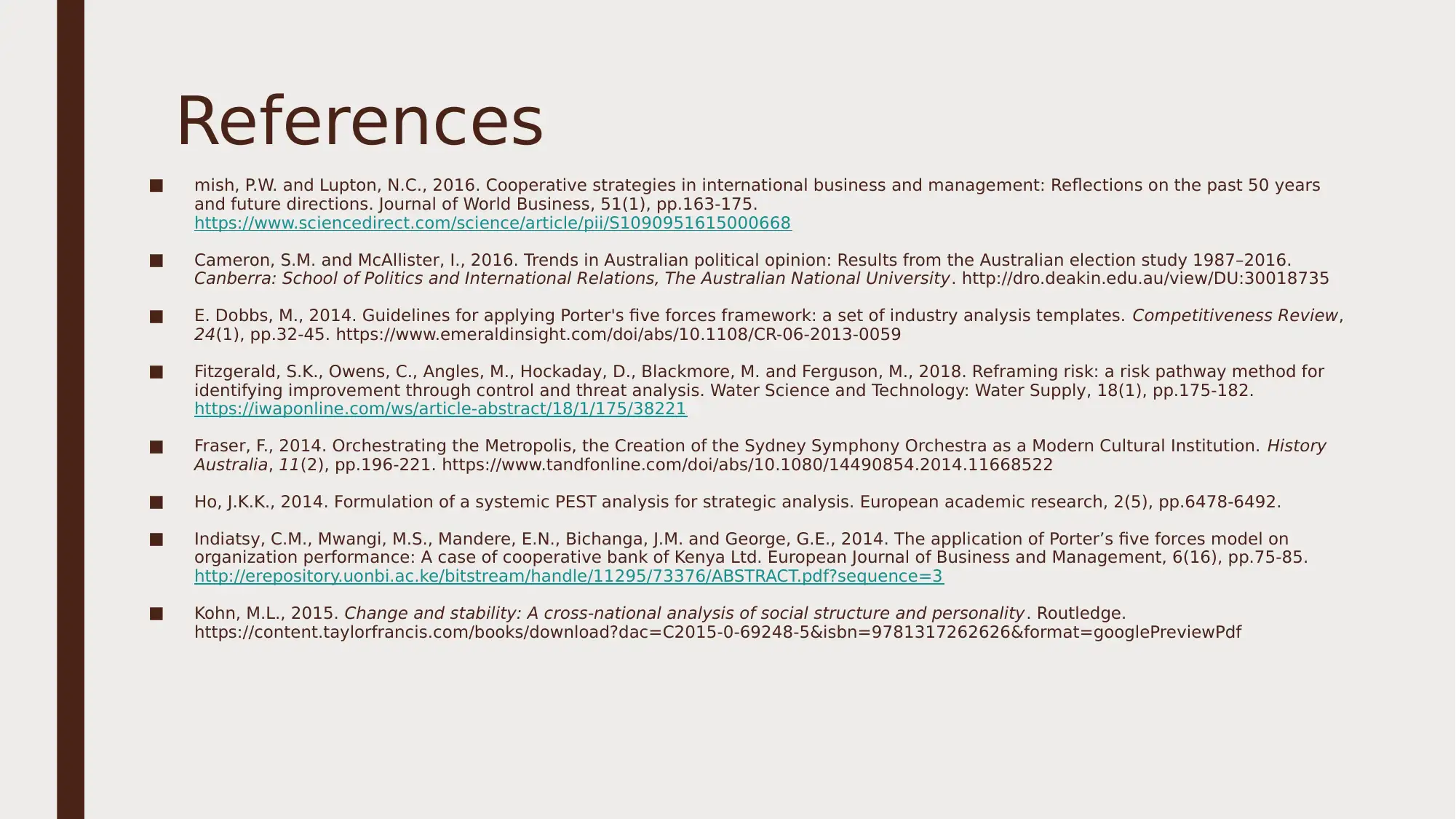
References
■ mish, P.W. and Lupton, N.C., 2016. Cooperative strategies in international business and management: Reflections on the past 50 years
and future directions. Journal of World Business, 51(1), pp.163-175.
https://www.sciencedirect.com/science/article/pii/S1090951615000668
■ Cameron, S.M. and McAllister, I., 2016. Trends in Australian political opinion: Results from the Australian election study 1987–2016.
Canberra: School of Politics and International Relations, The Australian National University. http://dro.deakin.edu.au/view/DU:30018735
■ E. Dobbs, M., 2014. Guidelines for applying Porter's five forces framework: a set of industry analysis templates. Competitiveness Review,
24(1), pp.32-45. https://www.emeraldinsight.com/doi/abs/10.1108/CR-06-2013-0059
■ Fitzgerald, S.K., Owens, C., Angles, M., Hockaday, D., Blackmore, M. and Ferguson, M., 2018. Reframing risk: a risk pathway method for
identifying improvement through control and threat analysis. Water Science and Technology: Water Supply, 18(1), pp.175-182.
https://iwaponline.com/ws/article-abstract/18/1/175/38221
■ Fraser, F., 2014. Orchestrating the Metropolis, the Creation of the Sydney Symphony Orchestra as a Modern Cultural Institution. History
Australia, 11(2), pp.196-221. https://www.tandfonline.com/doi/abs/10.1080/14490854.2014.11668522
■ Ho, J.K.K., 2014. Formulation of a systemic PEST analysis for strategic analysis. European academic research, 2(5), pp.6478-6492.
■ Indiatsy, C.M., Mwangi, M.S., Mandere, E.N., Bichanga, J.M. and George, G.E., 2014. The application of Porter’s five forces model on
organization performance: A case of cooperative bank of Kenya Ltd. European Journal of Business and Management, 6(16), pp.75-85.
http://erepository.uonbi.ac.ke/bitstream/handle/11295/73376/ABSTRACT.pdf?sequence=3
■ Kohn, M.L., 2015. Change and stability: A cross-national analysis of social structure and personality. Routledge.
https://content.taylorfrancis.com/books/download?dac=C2015-0-69248-5&isbn=9781317262626&format=googlePreviewPdf
■ mish, P.W. and Lupton, N.C., 2016. Cooperative strategies in international business and management: Reflections on the past 50 years
and future directions. Journal of World Business, 51(1), pp.163-175.
https://www.sciencedirect.com/science/article/pii/S1090951615000668
■ Cameron, S.M. and McAllister, I., 2016. Trends in Australian political opinion: Results from the Australian election study 1987–2016.
Canberra: School of Politics and International Relations, The Australian National University. http://dro.deakin.edu.au/view/DU:30018735
■ E. Dobbs, M., 2014. Guidelines for applying Porter's five forces framework: a set of industry analysis templates. Competitiveness Review,
24(1), pp.32-45. https://www.emeraldinsight.com/doi/abs/10.1108/CR-06-2013-0059
■ Fitzgerald, S.K., Owens, C., Angles, M., Hockaday, D., Blackmore, M. and Ferguson, M., 2018. Reframing risk: a risk pathway method for
identifying improvement through control and threat analysis. Water Science and Technology: Water Supply, 18(1), pp.175-182.
https://iwaponline.com/ws/article-abstract/18/1/175/38221
■ Fraser, F., 2014. Orchestrating the Metropolis, the Creation of the Sydney Symphony Orchestra as a Modern Cultural Institution. History
Australia, 11(2), pp.196-221. https://www.tandfonline.com/doi/abs/10.1080/14490854.2014.11668522
■ Ho, J.K.K., 2014. Formulation of a systemic PEST analysis for strategic analysis. European academic research, 2(5), pp.6478-6492.
■ Indiatsy, C.M., Mwangi, M.S., Mandere, E.N., Bichanga, J.M. and George, G.E., 2014. The application of Porter’s five forces model on
organization performance: A case of cooperative bank of Kenya Ltd. European Journal of Business and Management, 6(16), pp.75-85.
http://erepository.uonbi.ac.ke/bitstream/handle/11295/73376/ABSTRACT.pdf?sequence=3
■ Kohn, M.L., 2015. Change and stability: A cross-national analysis of social structure and personality. Routledge.
https://content.taylorfrancis.com/books/download?dac=C2015-0-69248-5&isbn=9781317262626&format=googlePreviewPdf
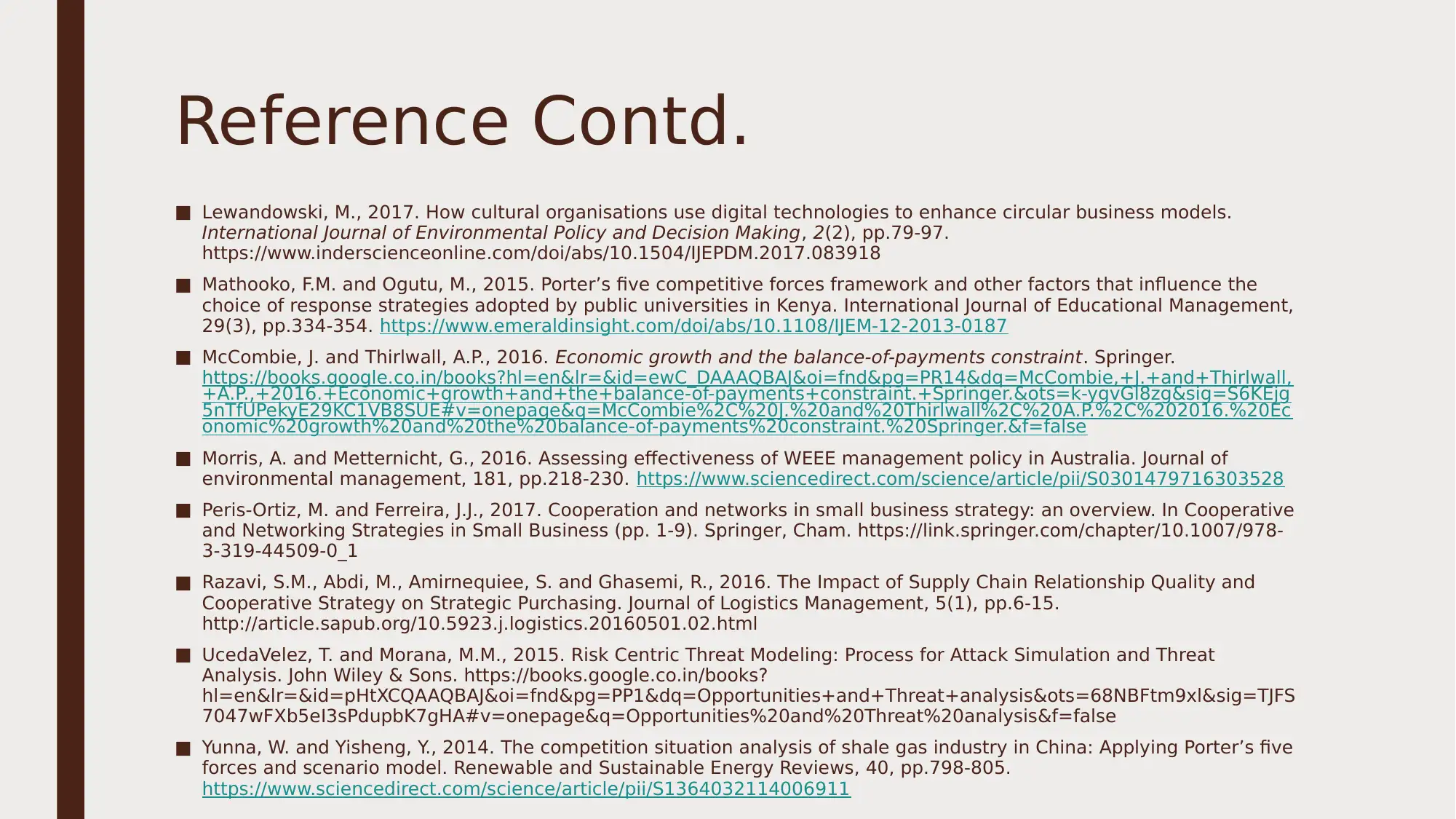
Reference Contd.
■ Lewandowski, M., 2017. How cultural organisations use digital technologies to enhance circular business models.
International Journal of Environmental Policy and Decision Making, 2(2), pp.79-97.
https://www.inderscienceonline.com/doi/abs/10.1504/IJEPDM.2017.083918
■ Mathooko, F.M. and Ogutu, M., 2015. Porter’s five competitive forces framework and other factors that influence the
choice of response strategies adopted by public universities in Kenya. International Journal of Educational Management,
29(3), pp.334-354. https://www.emeraldinsight.com/doi/abs/10.1108/IJEM-12-2013-0187
■ McCombie, J. and Thirlwall, A.P., 2016. Economic growth and the balance-of-payments constraint. Springer.
https://books.google.co.in/books?hl=en&lr=&id=ewC_DAAAQBAJ&oi=fnd&pg=PR14&dq=McCombie,+J.+and+Thirlwall,
+A.P.,+2016.+Economic+growth+and+the+balance-of-payments+constraint.+Springer.&ots=k-ygvGl8zg&sig=S6KEjg
5nTfUPekyE29KC1VB8SUE#v=onepage&q=McCombie%2C%20J.%20and%20Thirlwall%2C%20A.P.%2C%202016.%20Ec
onomic%20growth%20and%20the%20balance-of-payments%20constraint.%20Springer.&f=false
■ Morris, A. and Metternicht, G., 2016. Assessing effectiveness of WEEE management policy in Australia. Journal of
environmental management, 181, pp.218-230. https://www.sciencedirect.com/science/article/pii/S0301479716303528
■ Peris-Ortiz, M. and Ferreira, J.J., 2017. Cooperation and networks in small business strategy: an overview. In Cooperative
and Networking Strategies in Small Business (pp. 1-9). Springer, Cham. https://link.springer.com/chapter/10.1007/978-
3-319-44509-0_1
■ Razavi, S.M., Abdi, M., Amirnequiee, S. and Ghasemi, R., 2016. The Impact of Supply Chain Relationship Quality and
Cooperative Strategy on Strategic Purchasing. Journal of Logistics Management, 5(1), pp.6-15.
http://article.sapub.org/10.5923.j.logistics.20160501.02.html
■ UcedaVelez, T. and Morana, M.M., 2015. Risk Centric Threat Modeling: Process for Attack Simulation and Threat
Analysis. John Wiley & Sons. https://books.google.co.in/books?
hl=en&lr=&id=pHtXCQAAQBAJ&oi=fnd&pg=PP1&dq=Opportunities+and+Threat+analysis&ots=68NBFtm9xl&sig=TJFS
7047wFXb5eI3sPdupbK7gHA#v=onepage&q=Opportunities%20and%20Threat%20analysis&f=false
■ Yunna, W. and Yisheng, Y., 2014. The competition situation analysis of shale gas industry in China: Applying Porter’s five
forces and scenario model. Renewable and Sustainable Energy Reviews, 40, pp.798-805.
https://www.sciencedirect.com/science/article/pii/S1364032114006911
■ Lewandowski, M., 2017. How cultural organisations use digital technologies to enhance circular business models.
International Journal of Environmental Policy and Decision Making, 2(2), pp.79-97.
https://www.inderscienceonline.com/doi/abs/10.1504/IJEPDM.2017.083918
■ Mathooko, F.M. and Ogutu, M., 2015. Porter’s five competitive forces framework and other factors that influence the
choice of response strategies adopted by public universities in Kenya. International Journal of Educational Management,
29(3), pp.334-354. https://www.emeraldinsight.com/doi/abs/10.1108/IJEM-12-2013-0187
■ McCombie, J. and Thirlwall, A.P., 2016. Economic growth and the balance-of-payments constraint. Springer.
https://books.google.co.in/books?hl=en&lr=&id=ewC_DAAAQBAJ&oi=fnd&pg=PR14&dq=McCombie,+J.+and+Thirlwall,
+A.P.,+2016.+Economic+growth+and+the+balance-of-payments+constraint.+Springer.&ots=k-ygvGl8zg&sig=S6KEjg
5nTfUPekyE29KC1VB8SUE#v=onepage&q=McCombie%2C%20J.%20and%20Thirlwall%2C%20A.P.%2C%202016.%20Ec
onomic%20growth%20and%20the%20balance-of-payments%20constraint.%20Springer.&f=false
■ Morris, A. and Metternicht, G., 2016. Assessing effectiveness of WEEE management policy in Australia. Journal of
environmental management, 181, pp.218-230. https://www.sciencedirect.com/science/article/pii/S0301479716303528
■ Peris-Ortiz, M. and Ferreira, J.J., 2017. Cooperation and networks in small business strategy: an overview. In Cooperative
and Networking Strategies in Small Business (pp. 1-9). Springer, Cham. https://link.springer.com/chapter/10.1007/978-
3-319-44509-0_1
■ Razavi, S.M., Abdi, M., Amirnequiee, S. and Ghasemi, R., 2016. The Impact of Supply Chain Relationship Quality and
Cooperative Strategy on Strategic Purchasing. Journal of Logistics Management, 5(1), pp.6-15.
http://article.sapub.org/10.5923.j.logistics.20160501.02.html
■ UcedaVelez, T. and Morana, M.M., 2015. Risk Centric Threat Modeling: Process for Attack Simulation and Threat
Analysis. John Wiley & Sons. https://books.google.co.in/books?
hl=en&lr=&id=pHtXCQAAQBAJ&oi=fnd&pg=PP1&dq=Opportunities+and+Threat+analysis&ots=68NBFtm9xl&sig=TJFS
7047wFXb5eI3sPdupbK7gHA#v=onepage&q=Opportunities%20and%20Threat%20analysis&f=false
■ Yunna, W. and Yisheng, Y., 2014. The competition situation analysis of shale gas industry in China: Applying Porter’s five
forces and scenario model. Renewable and Sustainable Energy Reviews, 40, pp.798-805.
https://www.sciencedirect.com/science/article/pii/S1364032114006911
⊘ This is a preview!⊘
Do you want full access?
Subscribe today to unlock all pages.

Trusted by 1+ million students worldwide
1 out of 9
Your All-in-One AI-Powered Toolkit for Academic Success.
+13062052269
info@desklib.com
Available 24*7 on WhatsApp / Email
![[object Object]](/_next/static/media/star-bottom.7253800d.svg)
Unlock your academic potential
Copyright © 2020–2025 A2Z Services. All Rights Reserved. Developed and managed by ZUCOL.


